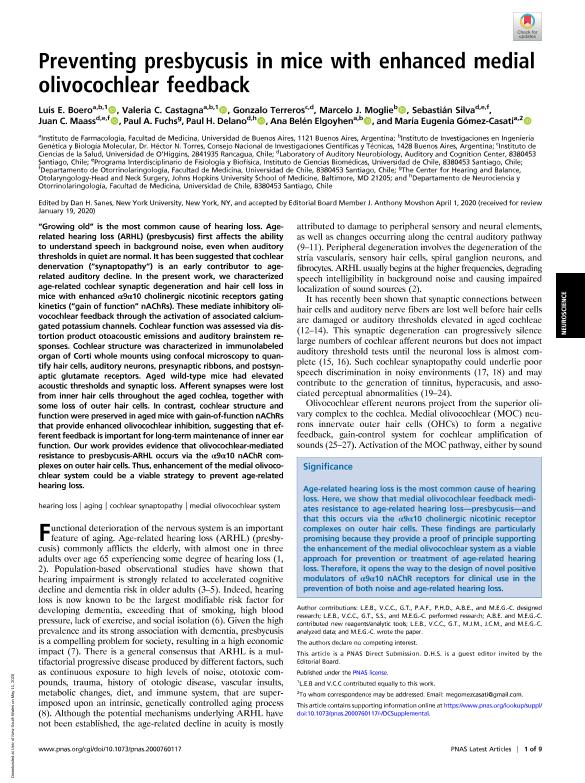Mostrar el registro sencillo del ítem
dc.contributor.author
Boero, Luis Ezequiel

dc.contributor.author
Castagna, Valeria Carolina

dc.contributor.author
Terreros, Gonzalo
dc.contributor.author
Moglie, Marcelo Javier

dc.contributor.author
Silva, Sebastián
dc.contributor.author
Maass, Juan C.
dc.contributor.author
Fuchs, Paul A.
dc.contributor.author
Delano, Paul H.
dc.contributor.author
Elgoyhen, Ana Belen

dc.contributor.author
Gomez Casati, Maria Eugenia

dc.date.available
2021-08-10T12:16:56Z
dc.date.issued
2020-05-26
dc.identifier.citation
Boero, Luis Ezequiel; Castagna, Valeria Carolina; Terreros, Gonzalo; Moglie, Marcelo Javier; Silva, Sebastián; et al.; Preventing presbycusis in mice with enhanced medial olivocochlear feedback; National Academy of Sciences; Proceedings of the National Academy of Sciences of The United States of America; 117; 21; 26-5-2020; 11811-11819
dc.identifier.issn
0027-8424
dc.identifier.uri
http://hdl.handle.net/11336/138061
dc.description.abstract
"Growing old" is the most common cause of hearing loss. Agerelated hearing loss (ARHL) (presbycusis) first affects the ability to understand speech in background noise, even when auditory thresholds in quiet are normal. It has been suggested that cochlear denervation ("synaptopathy") is an early contributor to agerelated auditory decline. In the present work, we characterized age-related cochlear synaptic degeneration and hair cell loss in mice with enhanced α9α10 cholinergic nicotinic receptors gating kinetics ("gain of function" nAChRs). These mediate inhibitory olivocochlear feedback through the activation of associated calciumgated potassium channels. Cochlear function was assessed via distortion product otoacoustic emissions and auditory brainstem responses. Cochlear structure was characterized in immunolabeled organ of Corti whole mounts using confocal microscopy to quantify hair cells, auditory neurons, presynaptic ribbons, and postsynaptic glutamate receptors. Aged wild-type mice had elevated acoustic thresholds and synaptic loss. Afferent synapses were lost from inner hair cells throughout the aged cochlea, together with some loss of outer hair cells. In contrast, cochlear structure and function were preserved in aged mice with gain-of-function nAChRs that provide enhanced olivocochlear inhibition, suggesting that efferent feedback is important for long-term maintenance of inner ear function. Our work provides evidence that olivocochlear-mediated resistance to presbycusis-ARHL occurs via the α9α10 nAChR complexes on outer hair cells. Thus, enhancement of the medial olivocochlear system could be a viable strategy to prevent age-related hearing loss.
dc.format
application/pdf
dc.language.iso
eng
dc.publisher
National Academy of Sciences

dc.rights
info:eu-repo/semantics/openAccess
dc.rights.uri
https://creativecommons.org/licenses/by-nc-sa/2.5/ar/
dc.subject
AGING
dc.subject
COCHLEAR SYNAPTOPATHY
dc.subject
HEARING LOSS
dc.subject
MEDIAL OLIVOCOCHLEAR SYSTEM
dc.subject.classification
Neurociencias

dc.subject.classification
Medicina Básica

dc.subject.classification
CIENCIAS MÉDICAS Y DE LA SALUD

dc.title
Preventing presbycusis in mice with enhanced medial olivocochlear feedback
dc.type
info:eu-repo/semantics/article
dc.type
info:ar-repo/semantics/artículo
dc.type
info:eu-repo/semantics/publishedVersion
dc.date.updated
2021-03-15T14:32:36Z
dc.identifier.eissn
1091-6490
dc.journal.volume
117
dc.journal.number
21
dc.journal.pagination
11811-11819
dc.journal.pais
Estados Unidos

dc.journal.ciudad
Washington DC
dc.description.fil
Fil: Boero, Luis Ezequiel. Consejo Nacional de Investigaciones Científicas y Técnicas. Instituto de Investigaciones en Ingeniería Genética y Biología Molecular "Dr. Héctor N. Torres"; Argentina. Universidad de Buenos Aires. Facultad de Medicina. Instituto de Farmacología; Argentina
dc.description.fil
Fil: Castagna, Valeria Carolina. Consejo Nacional de Investigaciones Científicas y Técnicas. Instituto de Investigaciones en Ingeniería Genética y Biología Molecular "Dr. Héctor N. Torres"; Argentina. Universidad de Buenos Aires. Facultad de Medicina. Instituto de Farmacología; Argentina
dc.description.fil
Fil: Terreros, Gonzalo. Universidad de Chile; Chile
dc.description.fil
Fil: Moglie, Marcelo Javier. Consejo Nacional de Investigaciones Científicas y Técnicas. Instituto de Investigaciones en Ingeniería Genética y Biología Molecular "Dr. Héctor N. Torres"; Argentina
dc.description.fil
Fil: Silva, Sebastián. Universidad de Chile; Chile
dc.description.fil
Fil: Maass, Juan C.. Universidad de Chile; Chile
dc.description.fil
Fil: Fuchs, Paul A.. University Johns Hopkins; Estados Unidos
dc.description.fil
Fil: Delano, Paul H.. Universidad de Chile; Chile
dc.description.fil
Fil: Elgoyhen, Ana Belen. Consejo Nacional de Investigaciones Científicas y Técnicas. Instituto de Investigaciones en Ingeniería Genética y Biología Molecular "Dr. Héctor N. Torres"; Argentina. Universidad de Buenos Aires. Facultad de Medicina. Instituto de Farmacología; Argentina
dc.description.fil
Fil: Gomez Casati, Maria Eugenia. Universidad de Buenos Aires. Facultad de Medicina. Instituto de Farmacología; Argentina. Consejo Nacional de Investigaciones Científicas y Técnicas. Instituto de Investigaciones en Ingeniería Genética y Biología Molecular "Dr. Héctor N. Torres"; Argentina
dc.journal.title
Proceedings of the National Academy of Sciences of The United States of America

dc.relation.alternativeid
info:eu-repo/semantics/altIdentifier/url/http://www.pnas.org/lookup/doi/10.1073/pnas.2000760117
dc.relation.alternativeid
info:eu-repo/semantics/altIdentifier/doi/http://dx.doi.org/10.1073/pnas.2000760117
Archivos asociados
